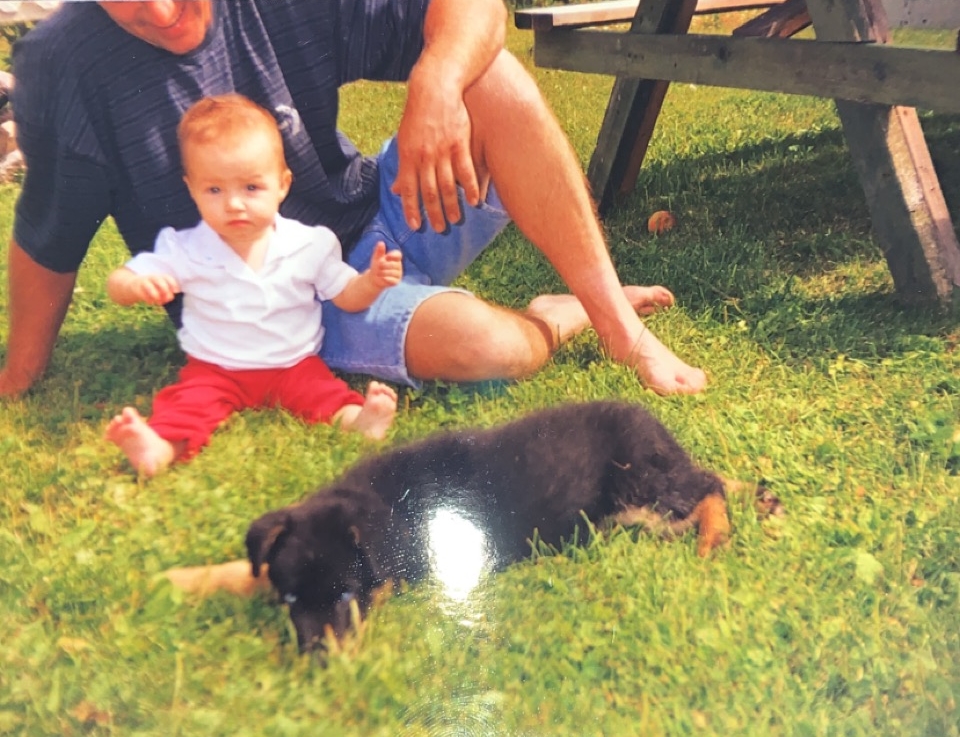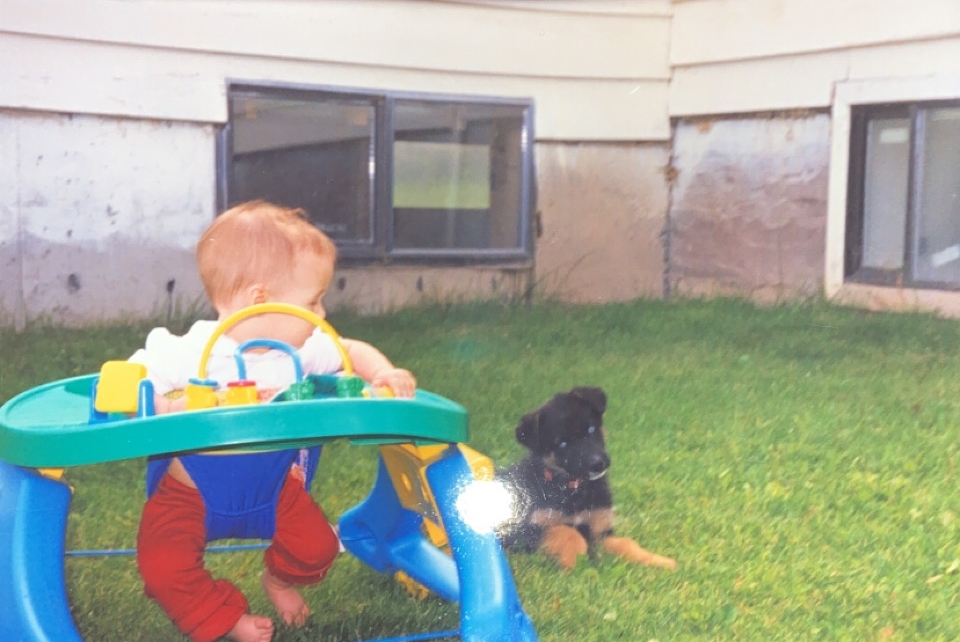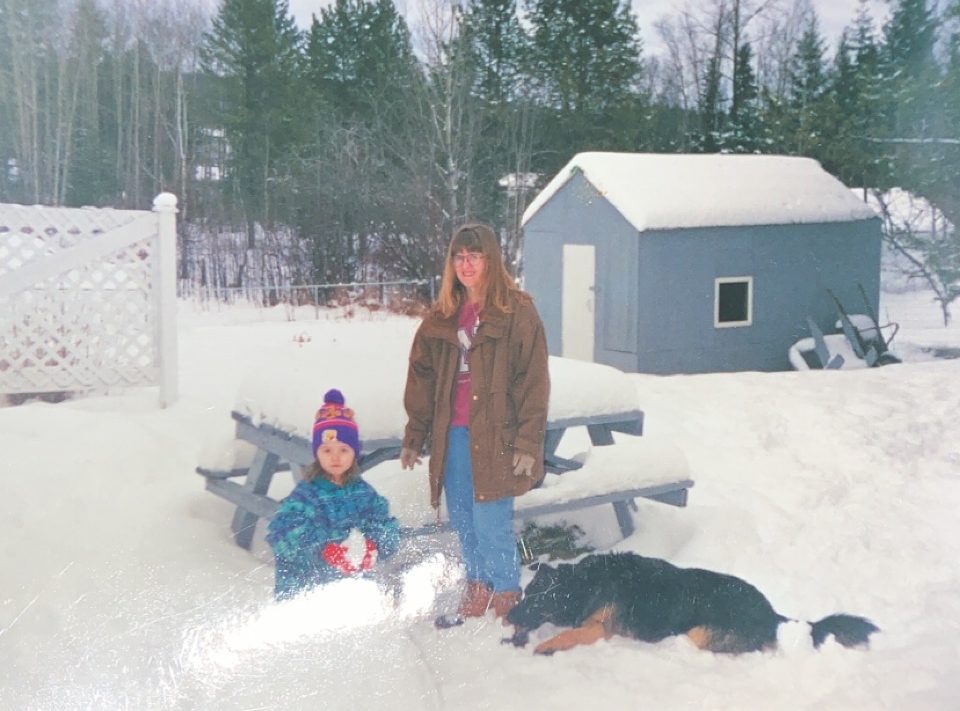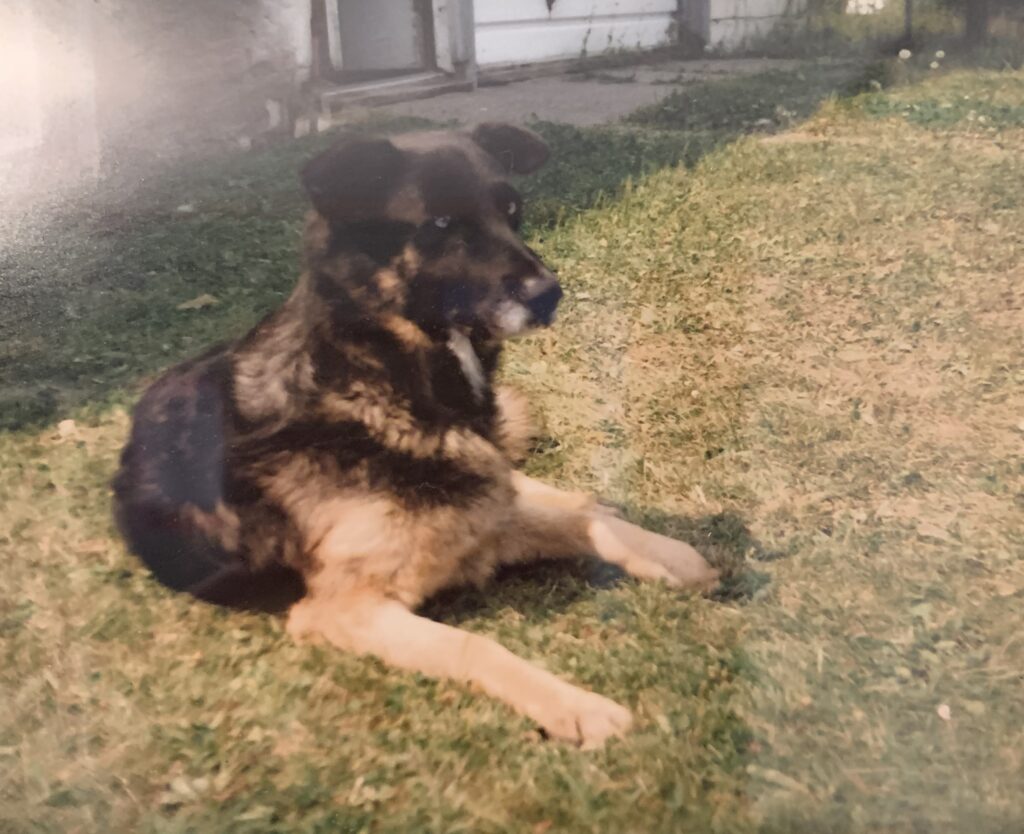LIFE WRITING
Exploring Indigenous Worldviews
Through Lived Experience
Having the capability to build connection and strong relationships with those around us has great influence on our overall well-being. The creation of powerful and trusting relationships will help in shaping who we are as individuals and will build our self-esteem to recognize that we belong and have purpose in this life. Acknowledging that we have people around us to turn to when things get tough or when we have accomplishments to celebrate, will always give a sense of feeling supported and loved. In my life, a common theme that has always been particularly important to me is relationships and interrelatedness with those that I care about most. Another theme that is important in my life is wisdom while continuously learning new things from others. With the term wisdom, it can be interpretated as having experience and a great sense of knowledge about a certain idea or event. When people think of others that possess a strong sense of wisdom and are particularly wise, the idea of grandparents and elders usually come to mind. Last year while finishing my Associate of Arts degree, I had the opportunity to take an Aboriginal Studies course that focused on Métis culture that was taught by a Métis artist and it was an experience that I will never forget. Before taking the course, I did not have any previous knowledge on the culture of Métis people and was so excited to engage in this learning experience to expand my education and knowledge further.
When the course began in January of 2021, my professor gave a course syllabus and outline on what was to be expected of us to do in tasks to demonstrate our learning which included creating an octopus bag, caribou hair tufting, and finger weaving while describing our processes in descriptive essays afterwards. At first, I was extremely intimidated because I am not the craftiest or much of a hands-on learner. The professor provided students with online pre-recorded video tutorials on how to complete these tasks and I felt that I needed extra help since the class was online due to the COVID-19 pandemic and did not have in person access to my professor. Therefore, my grandmother offered to help with the projects which led to an amazing learning experience and creating an even stronger bond between the two of us at the end of each project. She invited me over every day of the week to work on these projects together and taught me how to sew and have patience when it was not working for me. She was always eager to see my final grade after each project and essay and I think that the quality time and the teaching of her own techniques to her granddaughter meant a whole lot to her. This experience made me reflect on the importance of relationships and connection while also recognizing the significance of our elders in our lives. In Indigenous communities, elders play a key role in teaching generations to come about lived experience, cultural practice, language, and spirituality through story telling and the oral tradition. Interestingly, Anders (2008) stated that “in some Native American societies, tribal leaders consulted a counsel of grandmothers before making any decisions that would affect the whole community and through prayers and vision, a circle of Indigenous grandmothers convene from all corners of the world bringing wisdom and guidance to all humanity” (p. 117). When I read this quote, I connected it with the experience of the creation of material culture projects that Métis communities practice with my grandmother. I looked to her for her guidance and wisdom which was a great idea that I had adopted from Indigenous communities and their worldviews on elders and the valuable lessons that they hold for all of us.
The experience of examining Métis culture through creating projects such as the octopus bag, caribou hair tufting, and finger weaving that all came with great difficulty gave me an even stronger appreciation for the unique lives of others while giving a better understanding of those around the world. It taught me a tremendous amount of new knowledge based on material culture, identity, new techniques and skill, traditions, rituals, and so much more. It is wonderful to see how much powerful meaning that material culture has for the Métis people and how it symbolizes resilience and cultural distinctiveness with this Indigenous community of people. We see this through projects such as the octopus bag, caribou hair tufting, and the project of finger weaving. I strongly believe that expanding our knowledge on such cultural topics is what will make the world a better place while it can bring people together which will build and strengthen relationships leading to better learning experiences.
In conclusion, as I entered the Bachelor of Education program and have been introduced to the First People’s Principles of Learning derived from the scholarly works of Kirkness and Barnhardt (1991) and placed into foundational classroom content (Fraser, 2021), I often think of this experience with my grandmother that we enjoyed together and how I can use this experience to formulate a safe, respectful, and equitable learning space for my future Indigenous and settler elementary students. This experience brings the First People’s Principles of Learning in a classroom to life. With the principle of respect, the experience of learning about Métis culture taught me that there are indeed differences within cultures and as a future educator, it is my responsibility to create a shared space where equity, diversity and inclusion are always welcome and encouraged through culturally safe practices. This experience gave me the valuable lesson of the principle of relationships where shared information from others is rewarding to all learners. The sharing of knowledge will bring us closer together and building that type of knowledge empire from those around us will want us to learn more and collaborate better. In my future elementary classroom, helping strengthen relationships with my students will heighten motivation in learning and build stronger social skills. Students can in result move on to the principle of responsibilities to take what they have learned and be a mentor or role-model to other peers in the class. This lived experience also taught me about the valuable principle of reciprocity in the classroom. The idea of exchanging and circulating knowledge as a gift with no right or wrong was demonstrated through my experience of creating Métis art and creative expression that was given to me as a gift through Indigenous spiritual and symbolic lessons of material culture. Although these projects were very new and difficult to me, I still tried to create them to the best of my ability with my grandmother’s assistance because I appreciated the gift of knowledge that was passed on to me. In my future elementary school classroom, students can learn new things and will recognize that they can be brave enough to participate without being judged by their peers in being wrong or incorrect. Classrooms are all about learning and we learn from one another. The principle of reverence was viewed in my lived experience through having the opportunity to learn about Métis stories that represent lessons to be taught and learned. I learned that in order to survive and make a living for their families, Métis women often had to be creative and create material cultural items such as the octopus bag, caribou hair tufting, and finger weaving just to put food on the table for their children which indicates how strong, resilient, and courageous Indigenous people are. Bringing in guest speakers and Elders into my future elementary school classrooms to tell these heart-warming stories to the students could be a great exemplar of the reverence principle. With the remaining principles of reclamation, reconciliation and reflexivity, my lived experience of learning about Métis material culture represents these through reclaiming Indigenous ways of knowing and being by strongly maneuvering the concentration of cultural practices and tradition to establish identity which can be accomplished through spreading knowledge of the octopus bags, caribou hair tufting, and finger weaving as an example. Recognizing that these types of cultural practices, traditions, languages, and rituals were ignored, and attempted eradication took place needs to be addressed in the classroom to build trust, accountability, and leadership. Each principle of the First People’s Principles of Learning will add together in designing a classroom that will result in a space of additional reflexivity demonstrating to students that all human beings are unique with different beliefs, worldviews, and practices. We all have a story to tell and a journey of transformation through diverse life events. When we recognize this, it will keep learners informed and will grow feelings of empathy, kindness, compassion, and understanding for those around us. Hanson (2019) notes that “First Peoples perspectives and ongoing self inquiry is a way to improve as an educator” (p. 125). Every individual should be proud of who they are and where they came from and experiences such as this one teaches that skill. I am thankful for the experience of learning about the Métis material culture and the strong lasting bond it created between my grandmother and I which in result helped me identify the great value that relationships and connection have on learning which I will use on the road to become a future educator.






My Personal Teaching Philosophy
Carly Lorntsen
Education 346
University of Northern British Columbia
Throughout my life, I always recognized that I wanted to help others and make everyone feel like they belonged while giving them my kindness. Being a soft-spoken person, I never imagined that I would be in training to become an elementary school teacher, and it is a dream of mine that has come true. I give the uttermost credit to my parents, grandparents, and all educators that I have met along the way that have pushed me to go above and beyond in my academics while never doubting me. Without this strong support of individuals, I believe that my life would be completely different. Most importantly, I give a great amount of credit to myself in never giving up and having the confidence and courage to keep moving forward in my academics to reach this point in the Bachelor of Education program. As I briefly look at some aspects that placed me in teacher training, it gives me this colourful vision of what I wish to do to meet the needs of all my future students.
Every individual on planet Earth needs guidance, connection, and love. This particularly needs to begin during the first stages of life and development and must continue indefinitely. Without a sense of guidance, connection, and love, all living beings will feel utterly lost and alone. As you look in nature, it is the same for animals. For example, baby ducks follow in line behind mother duck, and baby deer follow along in line behind mother deer. If these beautiful creatures had an absence of guidance, connection, and love, they would feel lost in this world. It is the exact same for children in that guidance, connection, and love must be felt in their lives to build their sense of belonging, self-esteem, and self-efficacy. Therefore, my personal teaching philosophy is built on establishing connection and creating relationships with my students to ensure that they recognize that they can walk through that classroom door each day to a welcoming, safe, and kind classroom climate and culture with a teacher that will always put their needs first. As I have been taught this by my parents, grandparents, and educators throughout my life, I wish to give back to my future students one day as I know how important reassurance, faith, security, and encouragement is for a child to become the best version of themselves. I feel that as teachers, we must effectively ensure that students and their mental health are placed as a top priority which will lead to a successful learning experience that will carry with them throughout their lives and future goals moving forward.
HOW THE INFUSION OF INDIGENOUS EDUCATION IS A PART OF MY OVERALL PHILOSOPHY
Carly Lorntsen
Education 346
University of Northern British Columbia
Incorporating Indigenous education into my teaching philosophy is exceedingly important to me as I believe that it can enhance the learning experience for both students and the teacher. As my teaching philosophy focusses specifically on building relationships and connection while placing mental health as a top priority, Indigenous education will indeed help foster these goals in the learning environment as it emphasizes social and emotional learning. For example, I particularly love the idea of the medicine wheel and believe that it fits perfectly with my personal teaching philosophy. According to Ford-Ellis (2019), “The medicine wheel’s healing remedies reflect First Nations and Indigenous peoples’ traditional methods of healing integrating four areas of a person’s life: physical, spiritual, emotional, and psychological” (p. 90). I would like to incorporate the medicine wheel into my classroom to teach students about its significance and how they can examine their own physical, spiritual, emotional, and psychological health.
Furthermore, the idea of wisdom is highly important to my teaching philosophy as I have learned a great deal of incredible things from those older than me such as my parents and grandparents. Bringing Indigenous elders into my classroom for them to share their wisdom and rich knowledge of their culture could strengthen the learning experience further with incredible story telling through the oral tradition for my students. These worldviews will teach students how to connect themselves with those around them, their culture, ancestors, and the land.
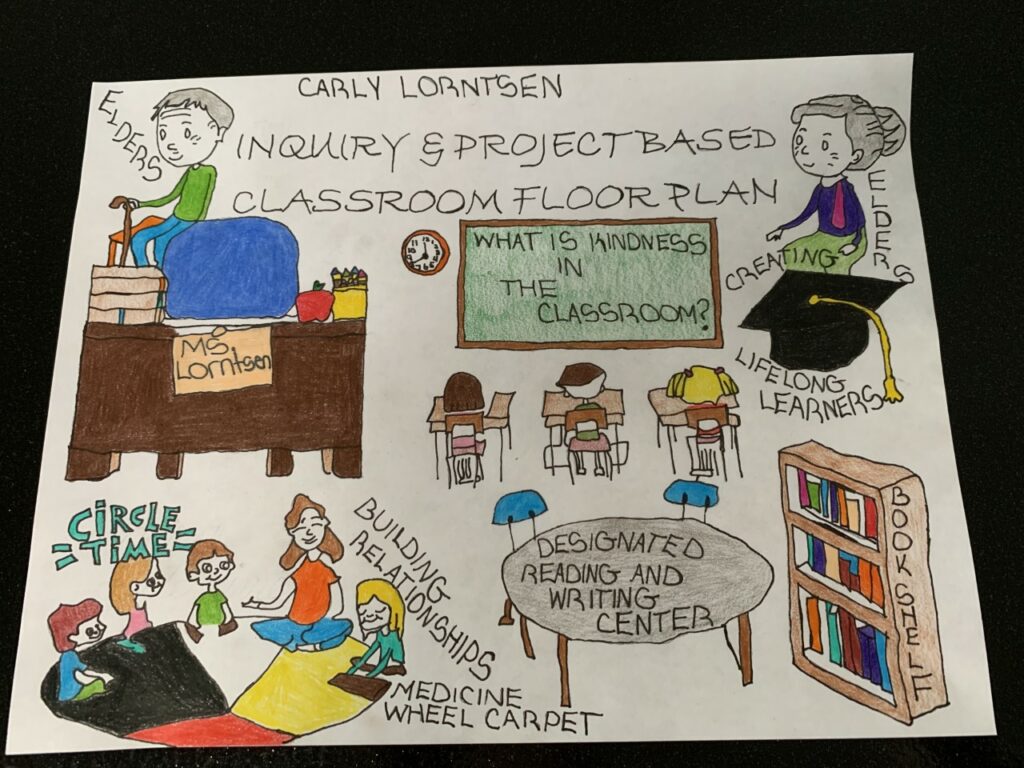
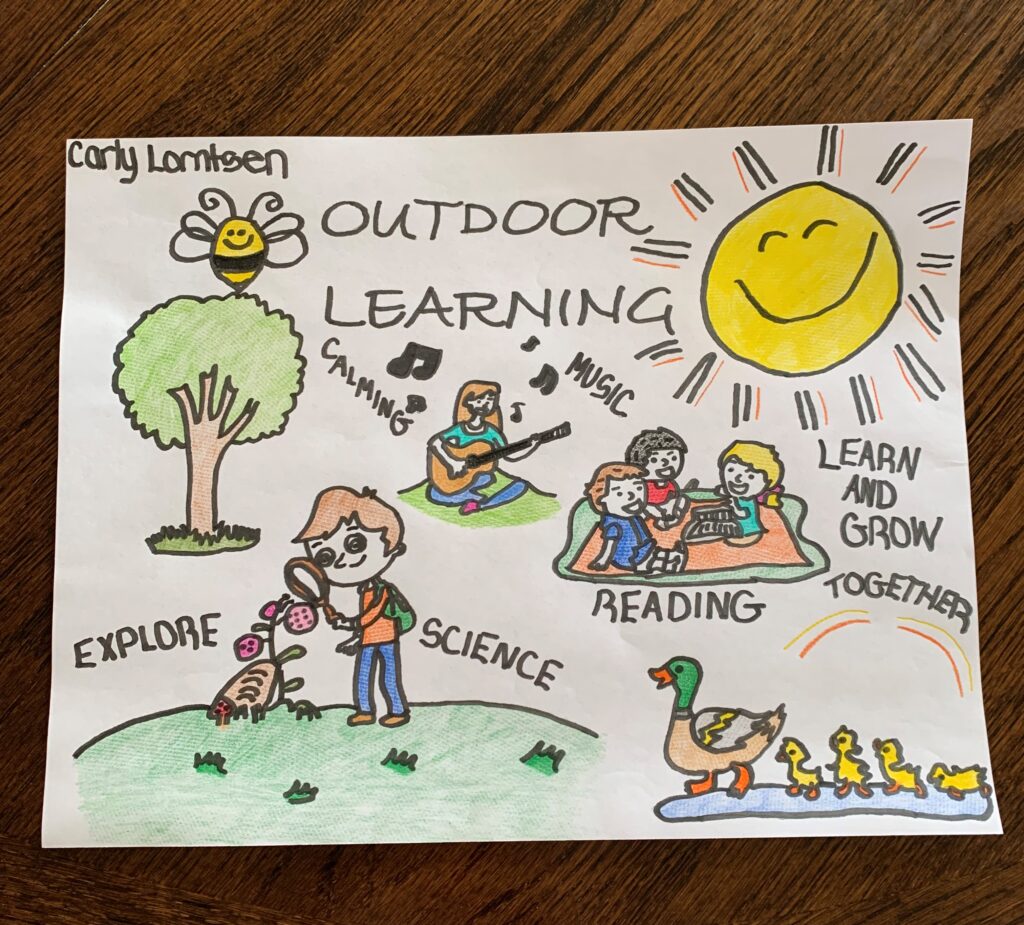
Carly Lorntsen
Education 446: Free Write
March 16, 2022
What was the lived experiences of FPPL and nine Rs in your Education 391 practicum?
My practicum was an incredible experience, and it is a lived experience that I will never forget for so many years to come. It was my very first-time setting foot in a classroom and having the opportunity to teach, and it was such an amazing feeling to swap positions of being a student for numerous years to teacher. Although I recognize that it takes many years and experience to become an effective teacher, I am extremely excited to absorb all this knowledge I have learned throughout my education and can bring it into my future classroom, one day.
Being placed in a kindergarten classroom for my first teaching practicum was a huge learning experience. I really focused on building strong, concrete relationships with the students while working one-on-one with each student while demonstrating the importance of patience and time to these students so that they felt completely safe, comfortable, and loved in their learning environment. My coaching teacher specifically made comments on my observations and to me, that concluded that being patient is a great quality to have in not only a teacher, but also a person and she told me I had this quality and that it is something to be proud of. I continuously told the students that it is always okay to make mistakes, and we are learning. I told them that I am also a student just like them, and I still make mistakes. After explaining this concept to one kindergarten student while she was attempting to sound out a word and was becoming frustrated with herself, acknowledging the idea that mistakes are always okay and that is how we learn, made her and all kindergarten students feel so comfortable and content. It brought me back to the idea of classroom climate and culture, and how it makes all the difference in a learning environment. Adopting the idea of building relationships with students and emphasizing the importance of patience and time from Indigenous peoples is extremely important in the classroom as it teaches our future generation how to be upstanding, exceptional, empathetic, and caring members of society.
A Little Girl and her Furry Best Friend
Exploring the Land
Carly Lorntsen
Education 446: Semester Two Life Writing
University of Northern British Columbia
It is a warm summer evening with a touch of soft-winds, and the scent of freshly cut grass is in the air. There are no responsibilities or any type of worries for a seven-year-old little girl who only wants to play and explore with her furry best friend. This best friend is a German Shepherd crossed with a Husky breed named Casper. As I reminisce, I remember growing up with this beautiful blue-eyed dog as my parents decided to adopt him a couple months after I was born. Casper was the runt of the litter meaning he was significantly smaller than the rest of his siblings with chances of health complications. Being only eight months younger than I was, he grew strong and healthy alongside myself while being there as I took my first steps, spoke my first words, observed me eat my new favorite foods, and all stages. As I became older, my favorite place in the world consisted of exploring the land of my mother and father’s acres at the house I grew up in, with my furry best friend.
I have been told various stories by my mother and father about how they would watch from inside, out the large bay windows into the acres of brush, and overwhelming amount of oak, birch, pine, cedar and elm trees, a seven-year-old girl playing with her dog and smiling or laughing at the sight of my small self picking up a stick and my dog gently taking the stick from me. My parents would also watch as they observed their daughter sitting on a rolling hill with her arm around her German Shephard pal watching the traffic drive by within the fenced acre yard. In this lived memory, I remember watching birds landing in the trees while being provided with free singing concerts, and grasshoppers frolicking in the green grass. As time passed, my father would call for me to come inside as it was getting late, but I would stay outside to watch the sunset on the rolling hill with Casper. I often wish that I could go back in time to these moments for a day as these were such simpler, tranquil, and serene days. I felt at complete ease and loads of safety in nature with the land and my best friend.
According to Greenwood and Leeuw (2007), “The land has become an extension of Indian thought and being, because in the words of a Pueblo Elder, ‘It is this place that holds our memories and the bones of our people…. This is the place that made us’” (p. 50). I really enjoyed this quote simply because as a child, I was inexperienced and unaware of the trauma and injustices that Indigenous Peoples have faced. As a current university student today, I feel grateful to have been educated about Indigenous Peoples and their incredible cultures, legacy, and what all human beings can do to help eliminate racism and make our world a better place for all. I recognize that there is still a large amount of learning to take place, but I am genuinely happy and relieved that more information about Indigenous Peoples and their culture is taking place in public schools and post-secondary institutions. According to Katz (2018), “Teachers need to know the why of change” (p. 196) which exemplifies that there is more learning that must occur for teachers regarding Indigenous education to create a knowledgeable network for students. I particularly feel honored to be living and studying on the traditional, unceded, and ancestral territory of the Lhtako Dene which is also the land that I explored and played upon as a child with my best friend Casper. Denise Augustine (unknown year) stated that “through the Indigenous lens, what we need to do is make sure we are nurturing our heart, nurturing our spirits, nurturing our relationships, and ensure that we are spending time outside” (p. 3). As I reminisce on this lived memory and this Indigenous worldview, I recognize the utter importance of the land and what it has to offer. Exploring the land will help strengthen our well-being through reducing stress and adding additional feelings of happiness. I remember this lived experience because it was my happy place where I felt safe, free, and at ease. At seven years old, I found a strong connection to the land as I created a strong bond with my childhood dog, but it was lost when my best friend became old, feeble, and sick at the age of twelve. Casper lived a long and happy life with my family and I, but I sure do miss our time together including the cuddles, and happiness he brought me as a child.
As old age and death is inevitable, life will always hold the beauty of memories and today, I can find peace and connection with the land as I recall the fond memories of my childhood dog and me. I find comfort in learning about the term reverence. Kirkness and Barnhardt (1991) stated that “it is well noted by the Elders that, ‘we are the land, and the land is us’”. Through life writing, I admire the stories that Indigenous Peoples share to connect themselves to people, place, and the land. This storytelling is often personal and will mold connections with others. Lived experiences and memories that can be small or big including the one I shared helps in defining the person we are today, shaping who we aim to be, and will give us a continuous source of comfort as we remember that specific time in our lives that has vanished, but will always remain in our heart. This lived experience as a child gave me a brand-new appreciation for the land and its significance.
